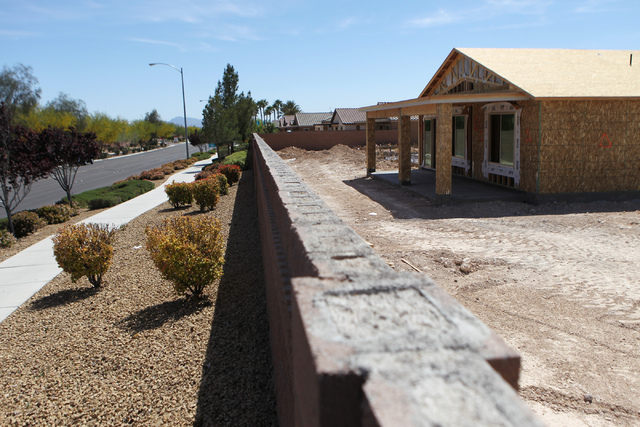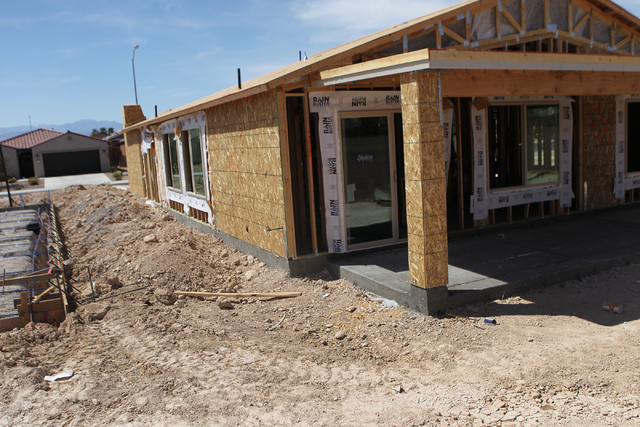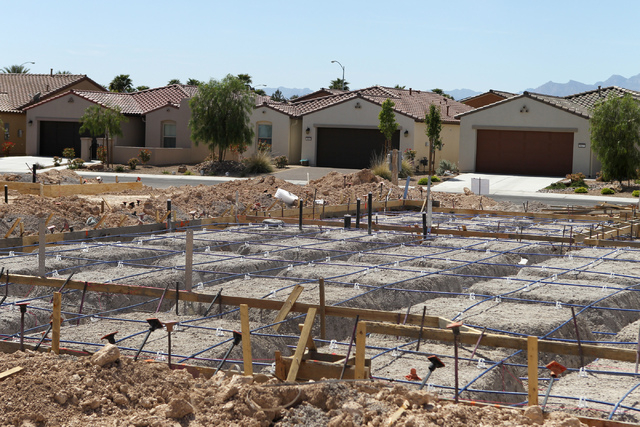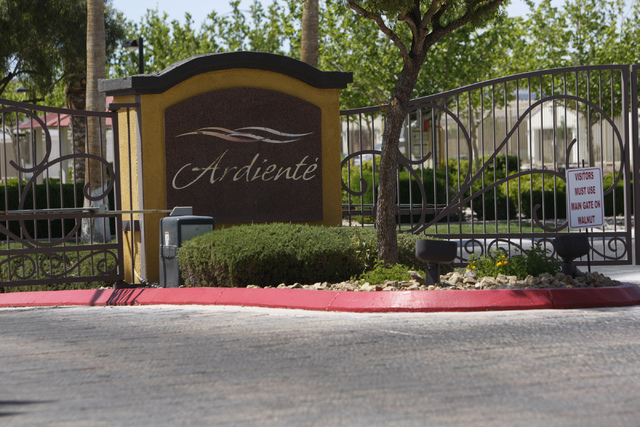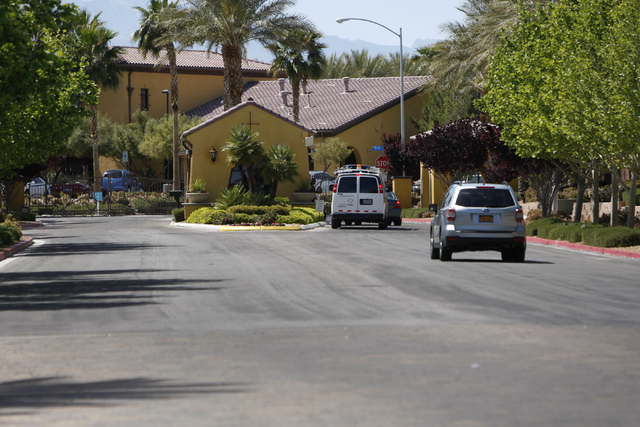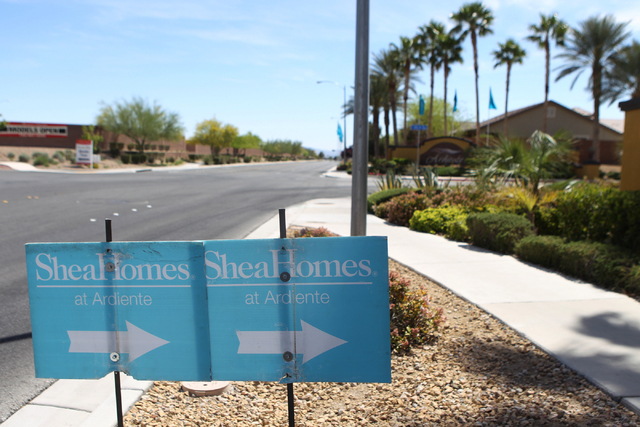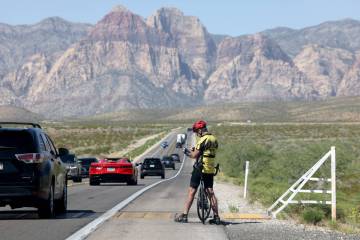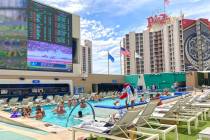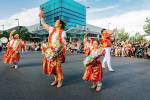New housing projects target 55-and-older crowd in Vegas Valley
There’ll be no telling kids to get off the lawns outside these new homes.
But that’s only because local cities now ban grass in front yards.
With the end of a 15-year drought in local development of communities for people 55 and older, the Las Vegas Valley is set to harvest a bumper crop of age-qualified neighborhoods.
Two major builders in opposite corners of the valley will begin selling new communities in 2015, while completion at a third continues in North Las Vegas.
The neighborhoods are designed to feed a flood of aging consumers.
“Life expectancy is increasing, and in baby boomers, there’s this pool of potential demand that is growing more broadly across the country,” said Brian Gordon, a principal in local housing research company SalesTraq.
Whether that pool is expanding quickly enough to absorb three big local projects is open for debate. Observers will also be watching for potential pressure on social services as older residents move to Southern Nevada.
To understand demand for homes and services, start with what’s on the drawing boards.
Building for the over-55 set is happening in three different parts of the valley.
In North Las Vegas, near Pecos Road and Tropical Parkway, Shea Homes is selling Ardiente, a community of about 800 single-family homes ranging from 1,218 to 2,444 square feet and priced from $198,990. Several hundred homes at Ardiente have been built since Centex Homes launched the community in 2005; Centex sold Ardiente to Shea in 2010 when it left the market amid the housing bust.
Then there’s Regency by Toll Brothers, Summerlin’s first age-restricted community since the 1990s. Regency will have 425 single-family homes on 100 acres in The Cliffs, a south Summerlin village, and will likely be a higher-priced option. Toll didn’t respond to a request for comment and the company’s website doesn’t list pricing at Regency, but its other local single-family-home communities are priced from the mid-$300,000s to the low $600,000s.
Finally, Lennar is planning 500 single-family homes in its Heritage at Cadence neighborhood in Henderson, near the Galleria at Sunset mall. As with Toll Brothers, Lennar isn’t disclosing pricing yet, but its homes will range from 1,700 to 3,000 square feet. Cadence officials have said homes in the master plan in general will start at around $250,000.
Add it all up, and there are more than 1,000 age-restricted homes planned or under construction valleywide. That’s equal to 17 percent of the 6,000 new homes local builders sold in 2014. The planned houses won’t hit the market all at once. Still, it’s a striking surge in supply for a market that hasn’t had more than one large-scale, age-restricted community get underway since the late 1990s.
Credit the boom to trends both economic and demographic.
A HEALTHY BUILDING SUBMARKET
During the recession, negative equity trapped Americans in their homes and kept them from moving, Gordon said.
Numbers from California data cruncher RealtyTrac showed that 13 percent of all U.S. homeowners with a mortgage in the fourth quarter were seriously underwater, owing at least 25 percent more than their home was worth. That was less than half of a peak rate of 29 percent in the second quarter of 2012.
“With broader improvements in the housing market and general improvements in the economy, retirees and potential retirees have more mobility than they did just a few years ago,” Gordon said.
Just as important, the number of Americans at or near retirement age is swelling. Baby boomers, born between 1946 and 1964, number more than 74 million, and another 28 million Americans are ages 67 to 82, Census Bureau figures show. The number of people expected to reach age 65 will grow 36 percent by 2020 alone.
That’s partly why building for the 55-plus segment has been one of the brighter spots in the new-homes market, according to research from the National Association of Home Builders. The Washington, D.C., trade group’s 55+ Housing Market Index recently hit its highest fourth-quarter reading since 2008, as older homeowners sold existing homes at favorable prices and moved into age-qualified neighborhoods. Association officials said in January that the age-restricted sector will remain one of the healthiest building submarkets nationwide for at least the next few years.
“As the economy continues to improve, so does our overall business,” said Timothy McCarthy, vice chairman of the association’s 50+ Housing Council. “Builders in this market have the opportunity to have tremendous success since the population we are serving is so vast.”
Those trends can only help builders and existing age-restricted communities in Nevada, a state that seniors have long seen as retiree-friendly for both financial and environmental reasons, said Douglas Proudfit, broker of Proudfit Realty in Sun City Anthem.
Proudfit, who’s specialized in Sun City Anthem sales for 15 years and who closes about 125 homes a year in the Henderson community, said most of his clients are fleeing the high cost of living in California, or the winters of New York and Chicago. Proudfit said he also sees a fair amount of in-migration from pricey markets in the Pacific Northwest.
“Nevada has low taxes and a good climate, and there’s so much entertainment in the area,” he said.
It doesn’t hurt that the Silver State routinely lands on lists of the best states for retirees. In 2015 alone, Kiplinger’s Personal Finance and consumer-finance website The Motley Fool ranked Nevada in the top three for retiree living. Their main reason? Taxes. Kiplinger’s pointed to the state’s lack of income and estate taxes, plus sales-tax exemptions on food and medications, in referring to the state’s “jackpot of savings.”
The Motley Fool pegged Nevada’s average state and local tax burden at $3,370 a year — 52 percent below the national average.
Low taxes or not, it’s not a guarantee that Southern Nevada can attract enough retirees to absorb the new supply, given competition for buyers and today’s sluggish local market conditions.
KEEN COMPETITION FOR NEW PRODUCT
Older consumers looking at Southern Nevada already have tens of thousands of existing age-qualified homes to choose from, and that could mean stiff competition for new product.
Sun City Summerlin has 8,000 units, while Sun City Anthem has 7,200 homes. Sun City MacDonald Ranch has more than 2,500 units. Solera at Anthem, Sun City Aliante, and Siena just south of Summerlin add another 1,900 units each to existing stock. You could also count the 3,400-home Sun City Mesquite as competition, although Proudfit said that area is likelier to attract retirees from Utah, Idaho and Colorado than people from California or the Northeast.
What’s more, local new-home sales have struggled to grow, stalling at 6,000 to 6,500 closings a year for the last two years. Closings have defied local observers’ expectations that sales would grow as the economy improved.
But today’s jump in planned development shouldn’t suffer from competition, experts said.
That’s partly because the supply won’t come on line all at once. Rather, it will get built out as demand warrants.
Also, the plateau in new-home closings isn’t entirely because of a lack of interest among potential buyers.
One factor curbing sales is a delay in building entitlements from local municipalities, wrote Dennis Smith, president and CEO of Home Builders Research, in his Las Vegas Housing Market Newsletter in January.
It’s also difficult for builders to find large affordable and developable chunks of land — an issue that should also limit the size of any future 55-plus subdivisions, Proudfit said.
And within the age-qualified segment in particular, there’s pent-up demand, with no significant new area construction in nearly 15 years, Gordon said.
With many locals still suffering from negative equity, subpar credit and shaky consumer confidence, it will be up to in-migration of baby boomers in particular to boost new-home sales, Smith said in March.
Nationally, business is so good that it’s difficult for developers of 55-plus communities to keep up.
“While this growth in sales is welcome, many builders are challenged to ramp up home production to fill new home orders,” McCarthy said in February.
That may be the case here, too, as more people relocate. Only recently has Southern Nevada started to see “more meaningful net population growth,” Gordon said.
“So we would expect to see some increase in demand in coming years,” he said.
The growth in age-qualified neighborhoods could affect everyone in the market — even consumers who aren’t anywhere near retirement age.
A DEMAND FOR SERVICES
New senior-centered communities “expand the base of value in the community, generating property taxes and other public revenues,” Gordon said.
At the same time, seniors often need more services from both the public and private sectors, he added.
Americans making it to age 65 can expect to live past 90, according to a 2012 report from the Urban Land Institute.
The institute’s report cited growing senior demand for public transit, health care, pedestrian-friendly streets, arts, culture, adult education, libraries and retail stores.
Meeting some of those needs could help economic growth. But costs might come with some important services and policies, such as adding curb cuts to sidewalks and benches at transit stops, improving access to public restrooms, slowing traffic-light timing, upgrading sidewalks and creating zoning rules that let people rent out parts of their homes.
But population growth in Southern Nevada should be relatively balanced among all age groups, making it unlikely that older citizens will overwhelm the needs of other groups, Proudfit said.
Plus, developers of age-qualified communities are doing their best to fulfill demand for services themselves, Proudfit said.
As with the valley’s Sun Cities, planned communities for older residents have amenities for seniors who increasingly want to stay active and healthy as they age.
Ardiente’s 20,000-square-foot Ardiente Club has a fitness center, a group exercise studio, two pools, tennis courts, a billiards room and two chipping and putting greens, among other features.
Toll’s Regency will have a 17,000-square-foot recreation center, tennis courts, walking and biking trails and a “lifestyle director” to coordinate community events including golf outings, billiard tournaments and day trips.
At Heritage at Cadence, Lennar is also planning a rec center with more than 23,000 square feet of space, indoor and outdoor pools, a ballroom, exercise classes, craft rooms and a cafe.
“People who are 65, 70, or 75 today are out hiking mountains, and they’re engaged mentally,” Proudfit said. “There’s so much here to help keep them young. It’s very attractive to folks.”
Contact Jennifer Robison at jrobison@reviewjournal.com. Find @J_Robison1 on Twitter.



